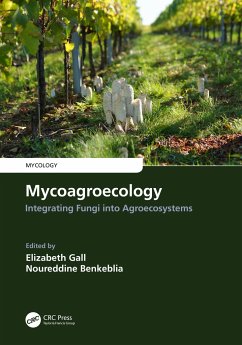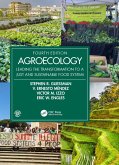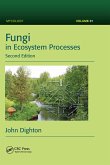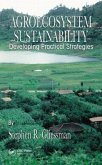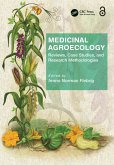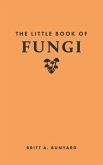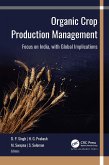Mycoagroecology
Integrating Fungi into Agroecosystems
Herausgeber: Gall, Elizabeth; Benkeblia, Noureddine
Mycoagroecology
Integrating Fungi into Agroecosystems
Herausgeber: Gall, Elizabeth; Benkeblia, Noureddine
- Gebundenes Buch
- Merkliste
- Auf die Merkliste
- Bewerten Bewerten
- Teilen
- Produkt teilen
- Produkterinnerung
- Produkterinnerung
This textbook discusses â mycoagroecology,â the emerging practice of cultivating fungal partners and products alongside plants in the agroecological systems to improve sustainability, food quality and yield while reducing instance of pests and reliance on artificial inputs.
Andere Kunden interessierten sich auch für
![The Fungal Community The Fungal Community]() The Fungal Community51,99 €
The Fungal Community51,99 €![Agroecology Agroecology]() Stephen R. Gliessman (University of California, Santa Cruz, USA)Agroecology114,99 €
Stephen R. Gliessman (University of California, Santa Cruz, USA)Agroecology114,99 €![Fungi in Ecosystem Processes Fungi in Ecosystem Processes]() John DightonFungi in Ecosystem Processes51,99 €
John DightonFungi in Ecosystem Processes51,99 €![Agroecosystem Sustainability Agroecosystem Sustainability]() Stephen R. Gliessman (ed.)Agroecosystem Sustainability261,99 €
Stephen R. Gliessman (ed.)Agroecosystem Sustainability261,99 €![Medicinal Agroecology Medicinal Agroecology]() Medicinal Agroecology140,99 €
Medicinal Agroecology140,99 €![The Little Book of Fungi The Little Book of Fungi]() Britt A. BunyardThe Little Book of Fungi14,99 €
Britt A. BunyardThe Little Book of Fungi14,99 €![Organic Crop Production Management Organic Crop Production Management]() Organic Crop Production Management173,99 €
Organic Crop Production Management173,99 €-
-
-
This textbook discusses â mycoagroecology,â the emerging practice of cultivating fungal partners and products alongside plants in the agroecological systems to improve sustainability, food quality and yield while reducing instance of pests and reliance on artificial inputs.
Hinweis: Dieser Artikel kann nur an eine deutsche Lieferadresse ausgeliefert werden.
Hinweis: Dieser Artikel kann nur an eine deutsche Lieferadresse ausgeliefert werden.
Produktdetails
- Produktdetails
- Mycology
- Verlag: Taylor & Francis Ltd
- Seitenzahl: 278
- Erscheinungstermin: 17. November 2022
- Englisch
- Abmessung: 182mm x 262mm x 22mm
- Gewicht: 740g
- ISBN-13: 9780367335243
- ISBN-10: 0367335247
- Artikelnr.: 64668241
- Herstellerkennzeichnung
- Libri GmbH
- Europaallee 1
- 36244 Bad Hersfeld
- gpsr@libri.de
- Mycology
- Verlag: Taylor & Francis Ltd
- Seitenzahl: 278
- Erscheinungstermin: 17. November 2022
- Englisch
- Abmessung: 182mm x 262mm x 22mm
- Gewicht: 740g
- ISBN-13: 9780367335243
- ISBN-10: 0367335247
- Artikelnr.: 64668241
- Herstellerkennzeichnung
- Libri GmbH
- Europaallee 1
- 36244 Bad Hersfeld
- gpsr@libri.de
Elizabeth "Izzie" Gall graduated from Tufts University in 2015 with a plant biology degree and a fierce passion for mycology. As an intern at the New York Botanical Garden, she founded Morel Dilemma, a podcast intended to impart her love of fungi to listeners of diverse backgrounds. After the internship ended, Izzie worked as a laboratory technician at New York University but continued the podcast, researching and producing episodes about mushroom cultivation, mycorrhizal relationships, foraging practices and safety, and fungi in the fossil record, among other topics. In 2017, Izzie attended graduate school in mycology and plant pathology at Michigan State University before returning to outreach. She is delighted to bring readers of all levels to a deeper understanding of fungi and their utility in natural and agricultural spaces. Izzie currently lives in Knoxville, Tennessee, U.S.A. with her husband Nate. Noureddine Benkeblia is a Professor of Crop Science, Department of Life Sciences, Faculty of Science and Technology, University of the West Indies Mona Campus, Jamaica. He is also Head of the Laboratory of Crop Science (Life Sciences Department) and Head of the Laboratory of Tree Fruits and Aromatic Crops (Biotechnology Centre), and coordinator of the graduate agriculture programmes. His main research areas focus on the environmental stresses on the physiology and biochemistry of crops including pre- and postharvest metabolism, and the metabolome. Prof. N. Benkeblia has an extensive research (more than 30 years) experience in horticultural sciences, and teaching at undergraduate, graduate and postgraduate levels in many countries. Prof. N. Benkeblia published over 230 publications including books, chapters and research papers. His is member of many international scientific societies NGO, and was recipient of many awards. He is also Associate Editor of several scientific journals e.g. Canadian Journal of Plant Science and PLOS Climate among others.
INTRODUCTION
1 Nutrient Cycling and Trophic Lifestyles (Elizabeth Gall and Noureddine
Benkeblia)
1.1 Photosynthesis: Primary Calorie Production
1.2 Primary and Secondary Metabolites
1.3 The Carbon Cycle
1.4 The Nitrogen Cycle
1.5 Heterotroph Lifestyles
1.5.1 Ingestive Heterotrophs
1.5.2 Absorptive Heterotrophs
1.6 Agroecological Applications
2 Evolution and Symbiosis (Elizabeth Gall)
2.1 Fitness and Genes
2.2 Species
2.3 Evolution and Evolutionary Pressures
2.4 Coevolution and Symbiosis
2.4.1 Mutualism
2.4.2 Predators and Prey
2.4.3 Competition
2.4.4 Commensalism and Parasitism
2.5 Context Dependence of Symbiosis
2.6 Agroecological Applications
3 Population Dynamics (Elizabeth Gall)
3.1 Energy Flow in Ecosystems
3.2 Growth Curves
3.3 Carrying Capacity and Population Cycles
3.4 Agroecological Applications
4 The Kingdom Fungi (Steven Stephenson and Elizabeth Gall)
4.1 Basic Structures of Fungi
4.2 Basic Classification of Fungi and Fungus-Like Organisms
4.2.1 Slime Molds
4.3 Taxonomy of Macrofungi
4.4 Taxonomy of Microfungi
4.5 Sexual Reproduction
4.5.1 Basidiomycetes
4.5.2 Ascomycetes
4.6 Asexual and Sexual Stages
4.7 Fundamental Niches of Fungi
4.7.1 Saprotrophic Fungi
4.7.2 Fungi in Symbioses
4.8 Secondary Metabolites of Interest
4.8.1 Culinary Use
4.8.2 Poisons or Toxins
4.8.3 Medicinal Compounds
5 Limiting Factors in Agriculture (Noureddine Benkeblia)
5.1 Meteorological Limiting Factors
5.1.1 Extreme Temperature as a Limiting Factor
5.1.1.1 High Temperatures
5.1.1.2 Low Temperatures
5.1.1.3 Long-Term Effects of Extreme Temperatures
5.1.2 CO2 Concentration as a Limiting Factor
5.2 Where Meteorological and Land Factors Meet: Water as a Limiting Factor
5.3 Limiting Land Factors: Nutrient Supply
5.3.1 Nitrogen (N)
5.3.2 Phosphorus (P)
5.3.3 Potassium (K)
6 Principles of Crop Breeding and Productivity (Elizabeth Gall)
6.1 Artificial Evolutionary Pressure
6.2 Metabolite Limits of Selective Breeding
6.3 Photosynthetic Limits of Selective Breeding
6.4 Evolved Alternatives to C3 Photosynthesis
6.4.1 C4 Photosynthesis
6.4.2 CAM Photosynthesis
6.4.3 Evolutionary Limits
6.5 Other Methods to Increase Yields and Efficiency
6.5.1 Intercropping
6.5.2 Crop Rotation
6.5.3 Directed Genetic Modification
6.6 Developing Cooperative Varieties of Plants and Fungi
7 Pests and Pest Management Methods (Juan F. Barrera)
7.1 Humans Versus Pests
7.2 Pest Management Strategies and Tactics
7.3 Economics and Ecology of Pests
7.3.1 The Economic Approach
7.3.2 The Ecological Approach
7.3.2.1 r-Pests
7.3.2.2 K-Pests
7.3.2.3 Intermediate Pests
7.4 The Future of Pest Management
7.4.1 Biologically Intensive IPM
7.4.2 Agroecologically Integrated Pest Management
7.4.3 Ecologically Based Pest Management (EBPM)
7.4.4 Total System Approach
7.4.5 Integrated Management of Biodiversity (IMB)
7.4.6 Integrated Crop Management (ICM)
7.4.7 Integrated Production
7.4.8 Integrated Agroecosystem Design and Management (IADM)
7.4.9 Crop Health and Salutogenesis
7.4.10 Holistic Pest Management (HPM)
7.5 Conclusion
8 Economic Factors in Agriculture (Elizabeth Gall and Barbara Laff)
8.1 Supply and Demand
8.1.1 Agricultural Supply: Balancing Inputs and Outputs with Costs and
Income
8.1.2 Agricultural Demand: Glut Price Cycles
8.2 Farm Sizes and Types
8.2.1 Farm Consolidation
8.3 Market Distortions
8.3.1 Government Interventions
8.4 Other Factors
8.4.1 Ecological Considerations
8.4.2 Intellectual Property Law
8.4.2.1 Plants as Intellectual Property
8.4.2.2 Patents and Seed Re-Use
8.5 Conclusion
9 The Green Revolution: Agricultural Shifts of the 20th Century (Elizabeth
Gall)
9.1 The United States: From Dust Bowl to Green Revolution
9.2 Mexico and The Initial Green Revolution
9.3 The Philippines, China, and Southeast Asia: Global Attention and Wild
Success
9.4 Patterns of the Green Revolution
9.5 Environmental Impacts of High-Input Systems
9.5.1 Fertilizer
9.5.2 Irrigation
9.5.3 Monoculture
9.6 Economic Impact
9.7 Government Interventions
9.8 Conclusion
MYCOAGROECOLOGY
10 The Second Green Revolution and the Role of Mycoagroecology (Elizabeth
Gall)
Pest-Control Agents, and Products
10.2 Agroecology: Integrating Productivity and Sustainability
10.2.1 Industrial Farms Value Production over Ecosystem Balance
10.2.2 Buffering the Ecosystem from the Farm
10.2.3 Closing the Loop: The Farm as an Island Ecosystem
10.2.4 The Farm as a Productive Portion of the Ecosystem
10.2.5 Incorporating Other Techniques
10.3 Mycoagroecology
10.3.1 Partners
10.3.2 Pests and Pest-Control Agents
10.3.3 Products
10.4 Mycoagroecology is Compatible with the Goals of the Second Green
Revolution
10.4.1 Address "Orphan" Regions and Crops
10.4.2 Return to Polyculture
10.4.3 Reduce the Need for Synthetic Inputs
10.4.4 Maintain Smallholder Competitiveness
10.5 Conclusion
FUNGI AS PARTNERS
11 Plant-Fungal Mutualisms (Jason C. Slot)
11.1 Plant-Fungal Mutualisms Vary According to Plant "Compartments"
11.2 Arbuscular Mycorrhizal Fungi Colonize Diverse Plant Roots Worldwide
11.3 Ectomycorrhizal Fungi Colonize Roots of Woody Plants in Northern and
Temperate Forests
11.4 Mycorrhizal Relationships are Structurally and Ecologically Diverse
11.4.1 Plants in a Community Can Benefit from Shared Mycorrhizal Networks
11.4.2 Mycoheterotrophs Exploit Plant-Fungal Mutualisms
11.5 Endophytic Fungi are Common Residents of Plant Tissues
11.6 Fungi can Provide Benefits to Other Plant Mutualisms
11.7 Plant-Fungal Mutualisms Require an Adapted Fungal Community
12 Incorporating Microbes into Agricultural Soils (Elizabeth Gall)
12.1 Types of Soil Microbes
12.1.1 Arbuscular Mycorrhizal (AM) Fungi
12.1.2 Ectomycorrhizal (ECM) Fungi
12.1.3 Root Endophytes
12.1.4 Other Soil Microbes
12.2 Industrial Agricultural Practices Destroy Soil Microbial Communities
12.2.1 Monoculture
12.2.2 Other Microbiome-Damaging Practices
12.3 Restoring Microbial Populations is Possible and Effective
12.4 Methods for Reintroducing Microbes to Agricultural Soils
12.4.1 Soil Inoculation
12.4.2 Trap Plants
12.4.3 Seed Coating
12.4.4 Monospecies vs. Community Inoculation
12.5 Management Practices for Soil Microbe Retention
12.6 Conclusion
FUNGI AS PESTS AND PEST-CONTROL AGENTS
13 Fungal Diseases in Agriculture: Significance, Management, and Control
(Noureddine Benkeblia)
13.2 Management and Control of Fungal Diseases in Agriculture
13.2.1 Chemical Control
13.2.2 Cultural Methods and Integrated Pest Management (IPM)
13.2.3 Biological Control Agents (BCA)
14 Fungal Pathogens in Forested Ecosystems (Denita Hadziabdic, Aaron
Onufrak, and Romina Gazis)
14.1 Detection Tools and Surveillance Methods
14.2 Fusarium Dieback - Invasive Shot Hole Borers
14.2.1 Disease Biology and Impact
14.2.2 Detection and Identification of the Pathogen and Vector
14.3 Laurel Wilt
14.3.1 Disease Biology and Impact
14.3.2 Detection and Identification of the Pathogen and Vector
14.4 Thousand Cankers Disease
14.4.1 Disease Biology and Impact
14.4.2 Detection and Identification of the Pathogen and Vector
14.5 Management of Fungal Diseases in Forested Areas
14.5.1 Cultural Practices
14.5.1.1 Quarantine and Sanitation
14.5.1.2 Resource Management
14.5.1.3 Plant Breeding
14.5.2 Chemical Management
14.5.3 Biological Control
15 Fungal Interactions with Other Pests (Guillermo Valero-David and Jason
C. Slot)
15.1 Insects
15.1.1 Fungi are an Important Food Source for Insects and Their Relatives
15.1.1.1 Attine Ants
15.1.1.2 Macroterminiti Termites
15.1.1.3 Ambrosia Beetles
15.1.2 Insects are Important Vectors of Plant Pathogenic Fungi
15.1.3 Fungi are Important Pathogens of Insects
15.1.3.1 Entomopathogenic Fungi in Soils
15.1.4 Fungal-Insect Interactions are Important Factors in Ecosystem
Processes
15.2 Nematodes
15.2.1 Nematodes Consume Fungi, Resulting in Varied Impacts on
Agroecosystems
15.2.2 Diverse Fungi Attack and Consume Nematodes
15.2.3 Nematodes and Plant Pathogenic Fungi Can Act Synergistically to
Cause Plant Disease
15.2.4 Coevolution of Fungi and Nematodes Has Resulted in Diverse
Associations
FUNGI AS PRODUCTS
16 Principles of Modern Fungal Cultivation (Elizabeth Gall)
16.1 Protein Value of Mushrooms
16.2 Limiting Factors in Mushroom Cultivation
16.2.1 Carbon Dioxide Concentrations
16.2.2 Carbon and Nitrogen
16.2.3 Other Macronutrients
16.2.4 Water
16.2.5 Light
16.2.6 Micronutrients
16.3 Modern Mushroom Cultivation
16.3.1 Starting Substrate
16.3.2 Mushroom Spawn
16.4 Genetic Aspects of Mushroom Cultivation
17 Integrating Fungi into Existing Farms (Elizabeth Gall)
17.1 Mushroom Cultivation Recycles Agro-Industrial Waste
17.2 Abundance of Lignocellulosic Waste
17.3 Selecting Substrates and Fungal Strains
17.4 Mushroom Cultivation Locations
Cultivation in Buildings
17.4.2 Mushroom Cultivation in Woods
17.4.3 Mushroom Cultivation in Fields
17.4.4 Co-Cropping with Ectomycorrhizal Fungi
17.5 Other Potential Uses of Mushrooms
17.5.1 Mushroom Growing Kits
17.5.2 Spent Mushroom Substrate
17.5.3 Mycoremediation of Damaged Landscapes
17.5.4 Bioprospecting: "Pests" with Agricultural Utility
17.6 Conclusion
18 Fungi in Food Processing (Noureddine Benkeblia)
18.1 Fermented and Aged Food Products
18.1.1 Fermented Foods are Diverse and Numerous
18.1.2 Breads
18.1.3 Fermented Meats
18.1.4 Cheeses
18.1.5 Yogurts and Other Fermented Dairy Products
18.2 Fermented Beverages
18.2.1 Alcoholic Fruit-Based Beverages (Wines)
18.2.2 Alcoholic Grain-based Beverages (Beers)
18.2.3 Other Alcoholic Beverages
18.2.4 Non-Alcoholic Fermented Beverages
18.3 Food Additives and Ingredients
18.4 Bioprocessing and Novel Food Production by Fungi
1 Nutrient Cycling and Trophic Lifestyles (Elizabeth Gall and Noureddine
Benkeblia)
1.1 Photosynthesis: Primary Calorie Production
1.2 Primary and Secondary Metabolites
1.3 The Carbon Cycle
1.4 The Nitrogen Cycle
1.5 Heterotroph Lifestyles
1.5.1 Ingestive Heterotrophs
1.5.2 Absorptive Heterotrophs
1.6 Agroecological Applications
2 Evolution and Symbiosis (Elizabeth Gall)
2.1 Fitness and Genes
2.2 Species
2.3 Evolution and Evolutionary Pressures
2.4 Coevolution and Symbiosis
2.4.1 Mutualism
2.4.2 Predators and Prey
2.4.3 Competition
2.4.4 Commensalism and Parasitism
2.5 Context Dependence of Symbiosis
2.6 Agroecological Applications
3 Population Dynamics (Elizabeth Gall)
3.1 Energy Flow in Ecosystems
3.2 Growth Curves
3.3 Carrying Capacity and Population Cycles
3.4 Agroecological Applications
4 The Kingdom Fungi (Steven Stephenson and Elizabeth Gall)
4.1 Basic Structures of Fungi
4.2 Basic Classification of Fungi and Fungus-Like Organisms
4.2.1 Slime Molds
4.3 Taxonomy of Macrofungi
4.4 Taxonomy of Microfungi
4.5 Sexual Reproduction
4.5.1 Basidiomycetes
4.5.2 Ascomycetes
4.6 Asexual and Sexual Stages
4.7 Fundamental Niches of Fungi
4.7.1 Saprotrophic Fungi
4.7.2 Fungi in Symbioses
4.8 Secondary Metabolites of Interest
4.8.1 Culinary Use
4.8.2 Poisons or Toxins
4.8.3 Medicinal Compounds
5 Limiting Factors in Agriculture (Noureddine Benkeblia)
5.1 Meteorological Limiting Factors
5.1.1 Extreme Temperature as a Limiting Factor
5.1.1.1 High Temperatures
5.1.1.2 Low Temperatures
5.1.1.3 Long-Term Effects of Extreme Temperatures
5.1.2 CO2 Concentration as a Limiting Factor
5.2 Where Meteorological and Land Factors Meet: Water as a Limiting Factor
5.3 Limiting Land Factors: Nutrient Supply
5.3.1 Nitrogen (N)
5.3.2 Phosphorus (P)
5.3.3 Potassium (K)
6 Principles of Crop Breeding and Productivity (Elizabeth Gall)
6.1 Artificial Evolutionary Pressure
6.2 Metabolite Limits of Selective Breeding
6.3 Photosynthetic Limits of Selective Breeding
6.4 Evolved Alternatives to C3 Photosynthesis
6.4.1 C4 Photosynthesis
6.4.2 CAM Photosynthesis
6.4.3 Evolutionary Limits
6.5 Other Methods to Increase Yields and Efficiency
6.5.1 Intercropping
6.5.2 Crop Rotation
6.5.3 Directed Genetic Modification
6.6 Developing Cooperative Varieties of Plants and Fungi
7 Pests and Pest Management Methods (Juan F. Barrera)
7.1 Humans Versus Pests
7.2 Pest Management Strategies and Tactics
7.3 Economics and Ecology of Pests
7.3.1 The Economic Approach
7.3.2 The Ecological Approach
7.3.2.1 r-Pests
7.3.2.2 K-Pests
7.3.2.3 Intermediate Pests
7.4 The Future of Pest Management
7.4.1 Biologically Intensive IPM
7.4.2 Agroecologically Integrated Pest Management
7.4.3 Ecologically Based Pest Management (EBPM)
7.4.4 Total System Approach
7.4.5 Integrated Management of Biodiversity (IMB)
7.4.6 Integrated Crop Management (ICM)
7.4.7 Integrated Production
7.4.8 Integrated Agroecosystem Design and Management (IADM)
7.4.9 Crop Health and Salutogenesis
7.4.10 Holistic Pest Management (HPM)
7.5 Conclusion
8 Economic Factors in Agriculture (Elizabeth Gall and Barbara Laff)
8.1 Supply and Demand
8.1.1 Agricultural Supply: Balancing Inputs and Outputs with Costs and
Income
8.1.2 Agricultural Demand: Glut Price Cycles
8.2 Farm Sizes and Types
8.2.1 Farm Consolidation
8.3 Market Distortions
8.3.1 Government Interventions
8.4 Other Factors
8.4.1 Ecological Considerations
8.4.2 Intellectual Property Law
8.4.2.1 Plants as Intellectual Property
8.4.2.2 Patents and Seed Re-Use
8.5 Conclusion
9 The Green Revolution: Agricultural Shifts of the 20th Century (Elizabeth
Gall)
9.1 The United States: From Dust Bowl to Green Revolution
9.2 Mexico and The Initial Green Revolution
9.3 The Philippines, China, and Southeast Asia: Global Attention and Wild
Success
9.4 Patterns of the Green Revolution
9.5 Environmental Impacts of High-Input Systems
9.5.1 Fertilizer
9.5.2 Irrigation
9.5.3 Monoculture
9.6 Economic Impact
9.7 Government Interventions
9.8 Conclusion
MYCOAGROECOLOGY
10 The Second Green Revolution and the Role of Mycoagroecology (Elizabeth
Gall)
Pest-Control Agents, and Products
10.2 Agroecology: Integrating Productivity and Sustainability
10.2.1 Industrial Farms Value Production over Ecosystem Balance
10.2.2 Buffering the Ecosystem from the Farm
10.2.3 Closing the Loop: The Farm as an Island Ecosystem
10.2.4 The Farm as a Productive Portion of the Ecosystem
10.2.5 Incorporating Other Techniques
10.3 Mycoagroecology
10.3.1 Partners
10.3.2 Pests and Pest-Control Agents
10.3.3 Products
10.4 Mycoagroecology is Compatible with the Goals of the Second Green
Revolution
10.4.1 Address "Orphan" Regions and Crops
10.4.2 Return to Polyculture
10.4.3 Reduce the Need for Synthetic Inputs
10.4.4 Maintain Smallholder Competitiveness
10.5 Conclusion
FUNGI AS PARTNERS
11 Plant-Fungal Mutualisms (Jason C. Slot)
11.1 Plant-Fungal Mutualisms Vary According to Plant "Compartments"
11.2 Arbuscular Mycorrhizal Fungi Colonize Diverse Plant Roots Worldwide
11.3 Ectomycorrhizal Fungi Colonize Roots of Woody Plants in Northern and
Temperate Forests
11.4 Mycorrhizal Relationships are Structurally and Ecologically Diverse
11.4.1 Plants in a Community Can Benefit from Shared Mycorrhizal Networks
11.4.2 Mycoheterotrophs Exploit Plant-Fungal Mutualisms
11.5 Endophytic Fungi are Common Residents of Plant Tissues
11.6 Fungi can Provide Benefits to Other Plant Mutualisms
11.7 Plant-Fungal Mutualisms Require an Adapted Fungal Community
12 Incorporating Microbes into Agricultural Soils (Elizabeth Gall)
12.1 Types of Soil Microbes
12.1.1 Arbuscular Mycorrhizal (AM) Fungi
12.1.2 Ectomycorrhizal (ECM) Fungi
12.1.3 Root Endophytes
12.1.4 Other Soil Microbes
12.2 Industrial Agricultural Practices Destroy Soil Microbial Communities
12.2.1 Monoculture
12.2.2 Other Microbiome-Damaging Practices
12.3 Restoring Microbial Populations is Possible and Effective
12.4 Methods for Reintroducing Microbes to Agricultural Soils
12.4.1 Soil Inoculation
12.4.2 Trap Plants
12.4.3 Seed Coating
12.4.4 Monospecies vs. Community Inoculation
12.5 Management Practices for Soil Microbe Retention
12.6 Conclusion
FUNGI AS PESTS AND PEST-CONTROL AGENTS
13 Fungal Diseases in Agriculture: Significance, Management, and Control
(Noureddine Benkeblia)
13.2 Management and Control of Fungal Diseases in Agriculture
13.2.1 Chemical Control
13.2.2 Cultural Methods and Integrated Pest Management (IPM)
13.2.3 Biological Control Agents (BCA)
14 Fungal Pathogens in Forested Ecosystems (Denita Hadziabdic, Aaron
Onufrak, and Romina Gazis)
14.1 Detection Tools and Surveillance Methods
14.2 Fusarium Dieback - Invasive Shot Hole Borers
14.2.1 Disease Biology and Impact
14.2.2 Detection and Identification of the Pathogen and Vector
14.3 Laurel Wilt
14.3.1 Disease Biology and Impact
14.3.2 Detection and Identification of the Pathogen and Vector
14.4 Thousand Cankers Disease
14.4.1 Disease Biology and Impact
14.4.2 Detection and Identification of the Pathogen and Vector
14.5 Management of Fungal Diseases in Forested Areas
14.5.1 Cultural Practices
14.5.1.1 Quarantine and Sanitation
14.5.1.2 Resource Management
14.5.1.3 Plant Breeding
14.5.2 Chemical Management
14.5.3 Biological Control
15 Fungal Interactions with Other Pests (Guillermo Valero-David and Jason
C. Slot)
15.1 Insects
15.1.1 Fungi are an Important Food Source for Insects and Their Relatives
15.1.1.1 Attine Ants
15.1.1.2 Macroterminiti Termites
15.1.1.3 Ambrosia Beetles
15.1.2 Insects are Important Vectors of Plant Pathogenic Fungi
15.1.3 Fungi are Important Pathogens of Insects
15.1.3.1 Entomopathogenic Fungi in Soils
15.1.4 Fungal-Insect Interactions are Important Factors in Ecosystem
Processes
15.2 Nematodes
15.2.1 Nematodes Consume Fungi, Resulting in Varied Impacts on
Agroecosystems
15.2.2 Diverse Fungi Attack and Consume Nematodes
15.2.3 Nematodes and Plant Pathogenic Fungi Can Act Synergistically to
Cause Plant Disease
15.2.4 Coevolution of Fungi and Nematodes Has Resulted in Diverse
Associations
FUNGI AS PRODUCTS
16 Principles of Modern Fungal Cultivation (Elizabeth Gall)
16.1 Protein Value of Mushrooms
16.2 Limiting Factors in Mushroom Cultivation
16.2.1 Carbon Dioxide Concentrations
16.2.2 Carbon and Nitrogen
16.2.3 Other Macronutrients
16.2.4 Water
16.2.5 Light
16.2.6 Micronutrients
16.3 Modern Mushroom Cultivation
16.3.1 Starting Substrate
16.3.2 Mushroom Spawn
16.4 Genetic Aspects of Mushroom Cultivation
17 Integrating Fungi into Existing Farms (Elizabeth Gall)
17.1 Mushroom Cultivation Recycles Agro-Industrial Waste
17.2 Abundance of Lignocellulosic Waste
17.3 Selecting Substrates and Fungal Strains
17.4 Mushroom Cultivation Locations
Cultivation in Buildings
17.4.2 Mushroom Cultivation in Woods
17.4.3 Mushroom Cultivation in Fields
17.4.4 Co-Cropping with Ectomycorrhizal Fungi
17.5 Other Potential Uses of Mushrooms
17.5.1 Mushroom Growing Kits
17.5.2 Spent Mushroom Substrate
17.5.3 Mycoremediation of Damaged Landscapes
17.5.4 Bioprospecting: "Pests" with Agricultural Utility
17.6 Conclusion
18 Fungi in Food Processing (Noureddine Benkeblia)
18.1 Fermented and Aged Food Products
18.1.1 Fermented Foods are Diverse and Numerous
18.1.2 Breads
18.1.3 Fermented Meats
18.1.4 Cheeses
18.1.5 Yogurts and Other Fermented Dairy Products
18.2 Fermented Beverages
18.2.1 Alcoholic Fruit-Based Beverages (Wines)
18.2.2 Alcoholic Grain-based Beverages (Beers)
18.2.3 Other Alcoholic Beverages
18.2.4 Non-Alcoholic Fermented Beverages
18.3 Food Additives and Ingredients
18.4 Bioprocessing and Novel Food Production by Fungi
INTRODUCTION
1 Nutrient Cycling and Trophic Lifestyles (Elizabeth Gall and Noureddine
Benkeblia)
1.1 Photosynthesis: Primary Calorie Production
1.2 Primary and Secondary Metabolites
1.3 The Carbon Cycle
1.4 The Nitrogen Cycle
1.5 Heterotroph Lifestyles
1.5.1 Ingestive Heterotrophs
1.5.2 Absorptive Heterotrophs
1.6 Agroecological Applications
2 Evolution and Symbiosis (Elizabeth Gall)
2.1 Fitness and Genes
2.2 Species
2.3 Evolution and Evolutionary Pressures
2.4 Coevolution and Symbiosis
2.4.1 Mutualism
2.4.2 Predators and Prey
2.4.3 Competition
2.4.4 Commensalism and Parasitism
2.5 Context Dependence of Symbiosis
2.6 Agroecological Applications
3 Population Dynamics (Elizabeth Gall)
3.1 Energy Flow in Ecosystems
3.2 Growth Curves
3.3 Carrying Capacity and Population Cycles
3.4 Agroecological Applications
4 The Kingdom Fungi (Steven Stephenson and Elizabeth Gall)
4.1 Basic Structures of Fungi
4.2 Basic Classification of Fungi and Fungus-Like Organisms
4.2.1 Slime Molds
4.3 Taxonomy of Macrofungi
4.4 Taxonomy of Microfungi
4.5 Sexual Reproduction
4.5.1 Basidiomycetes
4.5.2 Ascomycetes
4.6 Asexual and Sexual Stages
4.7 Fundamental Niches of Fungi
4.7.1 Saprotrophic Fungi
4.7.2 Fungi in Symbioses
4.8 Secondary Metabolites of Interest
4.8.1 Culinary Use
4.8.2 Poisons or Toxins
4.8.3 Medicinal Compounds
5 Limiting Factors in Agriculture (Noureddine Benkeblia)
5.1 Meteorological Limiting Factors
5.1.1 Extreme Temperature as a Limiting Factor
5.1.1.1 High Temperatures
5.1.1.2 Low Temperatures
5.1.1.3 Long-Term Effects of Extreme Temperatures
5.1.2 CO2 Concentration as a Limiting Factor
5.2 Where Meteorological and Land Factors Meet: Water as a Limiting Factor
5.3 Limiting Land Factors: Nutrient Supply
5.3.1 Nitrogen (N)
5.3.2 Phosphorus (P)
5.3.3 Potassium (K)
6 Principles of Crop Breeding and Productivity (Elizabeth Gall)
6.1 Artificial Evolutionary Pressure
6.2 Metabolite Limits of Selective Breeding
6.3 Photosynthetic Limits of Selective Breeding
6.4 Evolved Alternatives to C3 Photosynthesis
6.4.1 C4 Photosynthesis
6.4.2 CAM Photosynthesis
6.4.3 Evolutionary Limits
6.5 Other Methods to Increase Yields and Efficiency
6.5.1 Intercropping
6.5.2 Crop Rotation
6.5.3 Directed Genetic Modification
6.6 Developing Cooperative Varieties of Plants and Fungi
7 Pests and Pest Management Methods (Juan F. Barrera)
7.1 Humans Versus Pests
7.2 Pest Management Strategies and Tactics
7.3 Economics and Ecology of Pests
7.3.1 The Economic Approach
7.3.2 The Ecological Approach
7.3.2.1 r-Pests
7.3.2.2 K-Pests
7.3.2.3 Intermediate Pests
7.4 The Future of Pest Management
7.4.1 Biologically Intensive IPM
7.4.2 Agroecologically Integrated Pest Management
7.4.3 Ecologically Based Pest Management (EBPM)
7.4.4 Total System Approach
7.4.5 Integrated Management of Biodiversity (IMB)
7.4.6 Integrated Crop Management (ICM)
7.4.7 Integrated Production
7.4.8 Integrated Agroecosystem Design and Management (IADM)
7.4.9 Crop Health and Salutogenesis
7.4.10 Holistic Pest Management (HPM)
7.5 Conclusion
8 Economic Factors in Agriculture (Elizabeth Gall and Barbara Laff)
8.1 Supply and Demand
8.1.1 Agricultural Supply: Balancing Inputs and Outputs with Costs and
Income
8.1.2 Agricultural Demand: Glut Price Cycles
8.2 Farm Sizes and Types
8.2.1 Farm Consolidation
8.3 Market Distortions
8.3.1 Government Interventions
8.4 Other Factors
8.4.1 Ecological Considerations
8.4.2 Intellectual Property Law
8.4.2.1 Plants as Intellectual Property
8.4.2.2 Patents and Seed Re-Use
8.5 Conclusion
9 The Green Revolution: Agricultural Shifts of the 20th Century (Elizabeth
Gall)
9.1 The United States: From Dust Bowl to Green Revolution
9.2 Mexico and The Initial Green Revolution
9.3 The Philippines, China, and Southeast Asia: Global Attention and Wild
Success
9.4 Patterns of the Green Revolution
9.5 Environmental Impacts of High-Input Systems
9.5.1 Fertilizer
9.5.2 Irrigation
9.5.3 Monoculture
9.6 Economic Impact
9.7 Government Interventions
9.8 Conclusion
MYCOAGROECOLOGY
10 The Second Green Revolution and the Role of Mycoagroecology (Elizabeth
Gall)
Pest-Control Agents, and Products
10.2 Agroecology: Integrating Productivity and Sustainability
10.2.1 Industrial Farms Value Production over Ecosystem Balance
10.2.2 Buffering the Ecosystem from the Farm
10.2.3 Closing the Loop: The Farm as an Island Ecosystem
10.2.4 The Farm as a Productive Portion of the Ecosystem
10.2.5 Incorporating Other Techniques
10.3 Mycoagroecology
10.3.1 Partners
10.3.2 Pests and Pest-Control Agents
10.3.3 Products
10.4 Mycoagroecology is Compatible with the Goals of the Second Green
Revolution
10.4.1 Address "Orphan" Regions and Crops
10.4.2 Return to Polyculture
10.4.3 Reduce the Need for Synthetic Inputs
10.4.4 Maintain Smallholder Competitiveness
10.5 Conclusion
FUNGI AS PARTNERS
11 Plant-Fungal Mutualisms (Jason C. Slot)
11.1 Plant-Fungal Mutualisms Vary According to Plant "Compartments"
11.2 Arbuscular Mycorrhizal Fungi Colonize Diverse Plant Roots Worldwide
11.3 Ectomycorrhizal Fungi Colonize Roots of Woody Plants in Northern and
Temperate Forests
11.4 Mycorrhizal Relationships are Structurally and Ecologically Diverse
11.4.1 Plants in a Community Can Benefit from Shared Mycorrhizal Networks
11.4.2 Mycoheterotrophs Exploit Plant-Fungal Mutualisms
11.5 Endophytic Fungi are Common Residents of Plant Tissues
11.6 Fungi can Provide Benefits to Other Plant Mutualisms
11.7 Plant-Fungal Mutualisms Require an Adapted Fungal Community
12 Incorporating Microbes into Agricultural Soils (Elizabeth Gall)
12.1 Types of Soil Microbes
12.1.1 Arbuscular Mycorrhizal (AM) Fungi
12.1.2 Ectomycorrhizal (ECM) Fungi
12.1.3 Root Endophytes
12.1.4 Other Soil Microbes
12.2 Industrial Agricultural Practices Destroy Soil Microbial Communities
12.2.1 Monoculture
12.2.2 Other Microbiome-Damaging Practices
12.3 Restoring Microbial Populations is Possible and Effective
12.4 Methods for Reintroducing Microbes to Agricultural Soils
12.4.1 Soil Inoculation
12.4.2 Trap Plants
12.4.3 Seed Coating
12.4.4 Monospecies vs. Community Inoculation
12.5 Management Practices for Soil Microbe Retention
12.6 Conclusion
FUNGI AS PESTS AND PEST-CONTROL AGENTS
13 Fungal Diseases in Agriculture: Significance, Management, and Control
(Noureddine Benkeblia)
13.2 Management and Control of Fungal Diseases in Agriculture
13.2.1 Chemical Control
13.2.2 Cultural Methods and Integrated Pest Management (IPM)
13.2.3 Biological Control Agents (BCA)
14 Fungal Pathogens in Forested Ecosystems (Denita Hadziabdic, Aaron
Onufrak, and Romina Gazis)
14.1 Detection Tools and Surveillance Methods
14.2 Fusarium Dieback - Invasive Shot Hole Borers
14.2.1 Disease Biology and Impact
14.2.2 Detection and Identification of the Pathogen and Vector
14.3 Laurel Wilt
14.3.1 Disease Biology and Impact
14.3.2 Detection and Identification of the Pathogen and Vector
14.4 Thousand Cankers Disease
14.4.1 Disease Biology and Impact
14.4.2 Detection and Identification of the Pathogen and Vector
14.5 Management of Fungal Diseases in Forested Areas
14.5.1 Cultural Practices
14.5.1.1 Quarantine and Sanitation
14.5.1.2 Resource Management
14.5.1.3 Plant Breeding
14.5.2 Chemical Management
14.5.3 Biological Control
15 Fungal Interactions with Other Pests (Guillermo Valero-David and Jason
C. Slot)
15.1 Insects
15.1.1 Fungi are an Important Food Source for Insects and Their Relatives
15.1.1.1 Attine Ants
15.1.1.2 Macroterminiti Termites
15.1.1.3 Ambrosia Beetles
15.1.2 Insects are Important Vectors of Plant Pathogenic Fungi
15.1.3 Fungi are Important Pathogens of Insects
15.1.3.1 Entomopathogenic Fungi in Soils
15.1.4 Fungal-Insect Interactions are Important Factors in Ecosystem
Processes
15.2 Nematodes
15.2.1 Nematodes Consume Fungi, Resulting in Varied Impacts on
Agroecosystems
15.2.2 Diverse Fungi Attack and Consume Nematodes
15.2.3 Nematodes and Plant Pathogenic Fungi Can Act Synergistically to
Cause Plant Disease
15.2.4 Coevolution of Fungi and Nematodes Has Resulted in Diverse
Associations
FUNGI AS PRODUCTS
16 Principles of Modern Fungal Cultivation (Elizabeth Gall)
16.1 Protein Value of Mushrooms
16.2 Limiting Factors in Mushroom Cultivation
16.2.1 Carbon Dioxide Concentrations
16.2.2 Carbon and Nitrogen
16.2.3 Other Macronutrients
16.2.4 Water
16.2.5 Light
16.2.6 Micronutrients
16.3 Modern Mushroom Cultivation
16.3.1 Starting Substrate
16.3.2 Mushroom Spawn
16.4 Genetic Aspects of Mushroom Cultivation
17 Integrating Fungi into Existing Farms (Elizabeth Gall)
17.1 Mushroom Cultivation Recycles Agro-Industrial Waste
17.2 Abundance of Lignocellulosic Waste
17.3 Selecting Substrates and Fungal Strains
17.4 Mushroom Cultivation Locations
Cultivation in Buildings
17.4.2 Mushroom Cultivation in Woods
17.4.3 Mushroom Cultivation in Fields
17.4.4 Co-Cropping with Ectomycorrhizal Fungi
17.5 Other Potential Uses of Mushrooms
17.5.1 Mushroom Growing Kits
17.5.2 Spent Mushroom Substrate
17.5.3 Mycoremediation of Damaged Landscapes
17.5.4 Bioprospecting: "Pests" with Agricultural Utility
17.6 Conclusion
18 Fungi in Food Processing (Noureddine Benkeblia)
18.1 Fermented and Aged Food Products
18.1.1 Fermented Foods are Diverse and Numerous
18.1.2 Breads
18.1.3 Fermented Meats
18.1.4 Cheeses
18.1.5 Yogurts and Other Fermented Dairy Products
18.2 Fermented Beverages
18.2.1 Alcoholic Fruit-Based Beverages (Wines)
18.2.2 Alcoholic Grain-based Beverages (Beers)
18.2.3 Other Alcoholic Beverages
18.2.4 Non-Alcoholic Fermented Beverages
18.3 Food Additives and Ingredients
18.4 Bioprocessing and Novel Food Production by Fungi
1 Nutrient Cycling and Trophic Lifestyles (Elizabeth Gall and Noureddine
Benkeblia)
1.1 Photosynthesis: Primary Calorie Production
1.2 Primary and Secondary Metabolites
1.3 The Carbon Cycle
1.4 The Nitrogen Cycle
1.5 Heterotroph Lifestyles
1.5.1 Ingestive Heterotrophs
1.5.2 Absorptive Heterotrophs
1.6 Agroecological Applications
2 Evolution and Symbiosis (Elizabeth Gall)
2.1 Fitness and Genes
2.2 Species
2.3 Evolution and Evolutionary Pressures
2.4 Coevolution and Symbiosis
2.4.1 Mutualism
2.4.2 Predators and Prey
2.4.3 Competition
2.4.4 Commensalism and Parasitism
2.5 Context Dependence of Symbiosis
2.6 Agroecological Applications
3 Population Dynamics (Elizabeth Gall)
3.1 Energy Flow in Ecosystems
3.2 Growth Curves
3.3 Carrying Capacity and Population Cycles
3.4 Agroecological Applications
4 The Kingdom Fungi (Steven Stephenson and Elizabeth Gall)
4.1 Basic Structures of Fungi
4.2 Basic Classification of Fungi and Fungus-Like Organisms
4.2.1 Slime Molds
4.3 Taxonomy of Macrofungi
4.4 Taxonomy of Microfungi
4.5 Sexual Reproduction
4.5.1 Basidiomycetes
4.5.2 Ascomycetes
4.6 Asexual and Sexual Stages
4.7 Fundamental Niches of Fungi
4.7.1 Saprotrophic Fungi
4.7.2 Fungi in Symbioses
4.8 Secondary Metabolites of Interest
4.8.1 Culinary Use
4.8.2 Poisons or Toxins
4.8.3 Medicinal Compounds
5 Limiting Factors in Agriculture (Noureddine Benkeblia)
5.1 Meteorological Limiting Factors
5.1.1 Extreme Temperature as a Limiting Factor
5.1.1.1 High Temperatures
5.1.1.2 Low Temperatures
5.1.1.3 Long-Term Effects of Extreme Temperatures
5.1.2 CO2 Concentration as a Limiting Factor
5.2 Where Meteorological and Land Factors Meet: Water as a Limiting Factor
5.3 Limiting Land Factors: Nutrient Supply
5.3.1 Nitrogen (N)
5.3.2 Phosphorus (P)
5.3.3 Potassium (K)
6 Principles of Crop Breeding and Productivity (Elizabeth Gall)
6.1 Artificial Evolutionary Pressure
6.2 Metabolite Limits of Selective Breeding
6.3 Photosynthetic Limits of Selective Breeding
6.4 Evolved Alternatives to C3 Photosynthesis
6.4.1 C4 Photosynthesis
6.4.2 CAM Photosynthesis
6.4.3 Evolutionary Limits
6.5 Other Methods to Increase Yields and Efficiency
6.5.1 Intercropping
6.5.2 Crop Rotation
6.5.3 Directed Genetic Modification
6.6 Developing Cooperative Varieties of Plants and Fungi
7 Pests and Pest Management Methods (Juan F. Barrera)
7.1 Humans Versus Pests
7.2 Pest Management Strategies and Tactics
7.3 Economics and Ecology of Pests
7.3.1 The Economic Approach
7.3.2 The Ecological Approach
7.3.2.1 r-Pests
7.3.2.2 K-Pests
7.3.2.3 Intermediate Pests
7.4 The Future of Pest Management
7.4.1 Biologically Intensive IPM
7.4.2 Agroecologically Integrated Pest Management
7.4.3 Ecologically Based Pest Management (EBPM)
7.4.4 Total System Approach
7.4.5 Integrated Management of Biodiversity (IMB)
7.4.6 Integrated Crop Management (ICM)
7.4.7 Integrated Production
7.4.8 Integrated Agroecosystem Design and Management (IADM)
7.4.9 Crop Health and Salutogenesis
7.4.10 Holistic Pest Management (HPM)
7.5 Conclusion
8 Economic Factors in Agriculture (Elizabeth Gall and Barbara Laff)
8.1 Supply and Demand
8.1.1 Agricultural Supply: Balancing Inputs and Outputs with Costs and
Income
8.1.2 Agricultural Demand: Glut Price Cycles
8.2 Farm Sizes and Types
8.2.1 Farm Consolidation
8.3 Market Distortions
8.3.1 Government Interventions
8.4 Other Factors
8.4.1 Ecological Considerations
8.4.2 Intellectual Property Law
8.4.2.1 Plants as Intellectual Property
8.4.2.2 Patents and Seed Re-Use
8.5 Conclusion
9 The Green Revolution: Agricultural Shifts of the 20th Century (Elizabeth
Gall)
9.1 The United States: From Dust Bowl to Green Revolution
9.2 Mexico and The Initial Green Revolution
9.3 The Philippines, China, and Southeast Asia: Global Attention and Wild
Success
9.4 Patterns of the Green Revolution
9.5 Environmental Impacts of High-Input Systems
9.5.1 Fertilizer
9.5.2 Irrigation
9.5.3 Monoculture
9.6 Economic Impact
9.7 Government Interventions
9.8 Conclusion
MYCOAGROECOLOGY
10 The Second Green Revolution and the Role of Mycoagroecology (Elizabeth
Gall)
Pest-Control Agents, and Products
10.2 Agroecology: Integrating Productivity and Sustainability
10.2.1 Industrial Farms Value Production over Ecosystem Balance
10.2.2 Buffering the Ecosystem from the Farm
10.2.3 Closing the Loop: The Farm as an Island Ecosystem
10.2.4 The Farm as a Productive Portion of the Ecosystem
10.2.5 Incorporating Other Techniques
10.3 Mycoagroecology
10.3.1 Partners
10.3.2 Pests and Pest-Control Agents
10.3.3 Products
10.4 Mycoagroecology is Compatible with the Goals of the Second Green
Revolution
10.4.1 Address "Orphan" Regions and Crops
10.4.2 Return to Polyculture
10.4.3 Reduce the Need for Synthetic Inputs
10.4.4 Maintain Smallholder Competitiveness
10.5 Conclusion
FUNGI AS PARTNERS
11 Plant-Fungal Mutualisms (Jason C. Slot)
11.1 Plant-Fungal Mutualisms Vary According to Plant "Compartments"
11.2 Arbuscular Mycorrhizal Fungi Colonize Diverse Plant Roots Worldwide
11.3 Ectomycorrhizal Fungi Colonize Roots of Woody Plants in Northern and
Temperate Forests
11.4 Mycorrhizal Relationships are Structurally and Ecologically Diverse
11.4.1 Plants in a Community Can Benefit from Shared Mycorrhizal Networks
11.4.2 Mycoheterotrophs Exploit Plant-Fungal Mutualisms
11.5 Endophytic Fungi are Common Residents of Plant Tissues
11.6 Fungi can Provide Benefits to Other Plant Mutualisms
11.7 Plant-Fungal Mutualisms Require an Adapted Fungal Community
12 Incorporating Microbes into Agricultural Soils (Elizabeth Gall)
12.1 Types of Soil Microbes
12.1.1 Arbuscular Mycorrhizal (AM) Fungi
12.1.2 Ectomycorrhizal (ECM) Fungi
12.1.3 Root Endophytes
12.1.4 Other Soil Microbes
12.2 Industrial Agricultural Practices Destroy Soil Microbial Communities
12.2.1 Monoculture
12.2.2 Other Microbiome-Damaging Practices
12.3 Restoring Microbial Populations is Possible and Effective
12.4 Methods for Reintroducing Microbes to Agricultural Soils
12.4.1 Soil Inoculation
12.4.2 Trap Plants
12.4.3 Seed Coating
12.4.4 Monospecies vs. Community Inoculation
12.5 Management Practices for Soil Microbe Retention
12.6 Conclusion
FUNGI AS PESTS AND PEST-CONTROL AGENTS
13 Fungal Diseases in Agriculture: Significance, Management, and Control
(Noureddine Benkeblia)
13.2 Management and Control of Fungal Diseases in Agriculture
13.2.1 Chemical Control
13.2.2 Cultural Methods and Integrated Pest Management (IPM)
13.2.3 Biological Control Agents (BCA)
14 Fungal Pathogens in Forested Ecosystems (Denita Hadziabdic, Aaron
Onufrak, and Romina Gazis)
14.1 Detection Tools and Surveillance Methods
14.2 Fusarium Dieback - Invasive Shot Hole Borers
14.2.1 Disease Biology and Impact
14.2.2 Detection and Identification of the Pathogen and Vector
14.3 Laurel Wilt
14.3.1 Disease Biology and Impact
14.3.2 Detection and Identification of the Pathogen and Vector
14.4 Thousand Cankers Disease
14.4.1 Disease Biology and Impact
14.4.2 Detection and Identification of the Pathogen and Vector
14.5 Management of Fungal Diseases in Forested Areas
14.5.1 Cultural Practices
14.5.1.1 Quarantine and Sanitation
14.5.1.2 Resource Management
14.5.1.3 Plant Breeding
14.5.2 Chemical Management
14.5.3 Biological Control
15 Fungal Interactions with Other Pests (Guillermo Valero-David and Jason
C. Slot)
15.1 Insects
15.1.1 Fungi are an Important Food Source for Insects and Their Relatives
15.1.1.1 Attine Ants
15.1.1.2 Macroterminiti Termites
15.1.1.3 Ambrosia Beetles
15.1.2 Insects are Important Vectors of Plant Pathogenic Fungi
15.1.3 Fungi are Important Pathogens of Insects
15.1.3.1 Entomopathogenic Fungi in Soils
15.1.4 Fungal-Insect Interactions are Important Factors in Ecosystem
Processes
15.2 Nematodes
15.2.1 Nematodes Consume Fungi, Resulting in Varied Impacts on
Agroecosystems
15.2.2 Diverse Fungi Attack and Consume Nematodes
15.2.3 Nematodes and Plant Pathogenic Fungi Can Act Synergistically to
Cause Plant Disease
15.2.4 Coevolution of Fungi and Nematodes Has Resulted in Diverse
Associations
FUNGI AS PRODUCTS
16 Principles of Modern Fungal Cultivation (Elizabeth Gall)
16.1 Protein Value of Mushrooms
16.2 Limiting Factors in Mushroom Cultivation
16.2.1 Carbon Dioxide Concentrations
16.2.2 Carbon and Nitrogen
16.2.3 Other Macronutrients
16.2.4 Water
16.2.5 Light
16.2.6 Micronutrients
16.3 Modern Mushroom Cultivation
16.3.1 Starting Substrate
16.3.2 Mushroom Spawn
16.4 Genetic Aspects of Mushroom Cultivation
17 Integrating Fungi into Existing Farms (Elizabeth Gall)
17.1 Mushroom Cultivation Recycles Agro-Industrial Waste
17.2 Abundance of Lignocellulosic Waste
17.3 Selecting Substrates and Fungal Strains
17.4 Mushroom Cultivation Locations
Cultivation in Buildings
17.4.2 Mushroom Cultivation in Woods
17.4.3 Mushroom Cultivation in Fields
17.4.4 Co-Cropping with Ectomycorrhizal Fungi
17.5 Other Potential Uses of Mushrooms
17.5.1 Mushroom Growing Kits
17.5.2 Spent Mushroom Substrate
17.5.3 Mycoremediation of Damaged Landscapes
17.5.4 Bioprospecting: "Pests" with Agricultural Utility
17.6 Conclusion
18 Fungi in Food Processing (Noureddine Benkeblia)
18.1 Fermented and Aged Food Products
18.1.1 Fermented Foods are Diverse and Numerous
18.1.2 Breads
18.1.3 Fermented Meats
18.1.4 Cheeses
18.1.5 Yogurts and Other Fermented Dairy Products
18.2 Fermented Beverages
18.2.1 Alcoholic Fruit-Based Beverages (Wines)
18.2.2 Alcoholic Grain-based Beverages (Beers)
18.2.3 Other Alcoholic Beverages
18.2.4 Non-Alcoholic Fermented Beverages
18.3 Food Additives and Ingredients
18.4 Bioprocessing and Novel Food Production by Fungi

